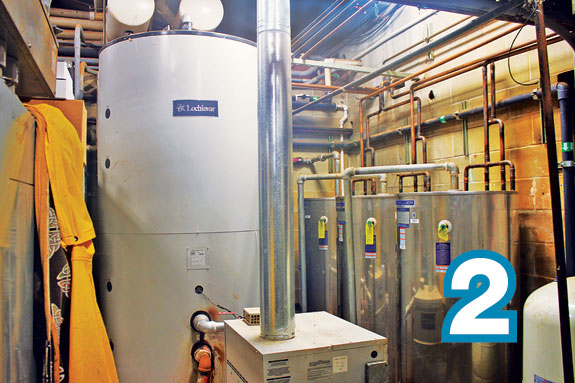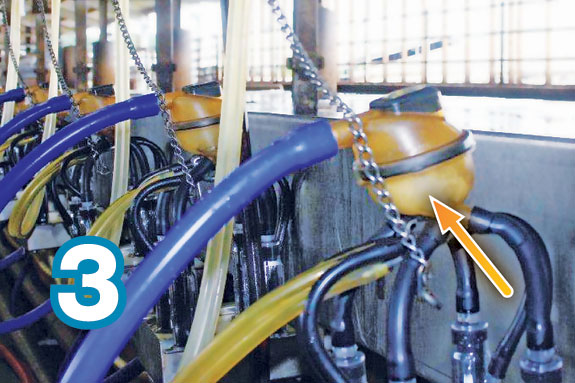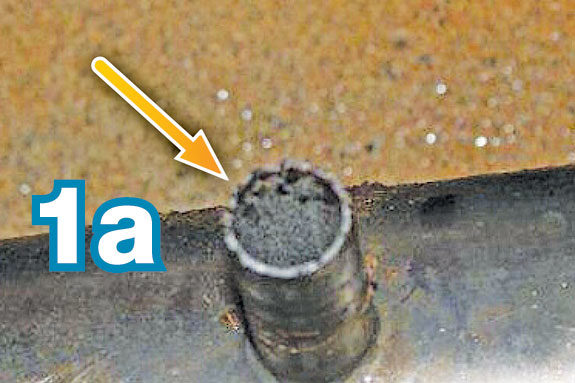Building a new milking facility – or renovating an old one – can be nerve-racking. There are so many decisions to make, and you need to move quickly so production can begin as soon as possible. But as we uncovered, it doesn’t pay to cut corners by installing equipment that isn’t up to the task. You may save a few dollars in upfront costs, but if your system is inadequate to allow for proper cleaning, your premium losses will be criminal.
This was the scene at our latest investigation: a 3,000-cow dairy that had been in business for more than 25 years was getting pinched on their premiums. They had recently renovated their facility and were hoping to improve their profits, not take a hit. So we began to search for clues in this “Case of the New Facility Fiasco.”

The first indication of problems in the system was a stainless steel nipple on the 3-inch milkline that appeared black and burnt.
This told us that the CIP system wasn’t working so the producer had tried to solve the problem by “shocking” the system with a high-alkaline chlorinated cleaner.
While it provides a short-term fix, shocking damages equipment and ultimately allows more bacteria into the system on rough surfaces.
We were confident that if we could identify the mechanical problems in the system that were hindering the CIP process, no further “shock treatments” would be necessary.

When bacteria counts are high, it’s often because the water used in cleaning is inadequate in either volume or heat. This new facility, however, had a brand-new heater that was working properly and supplying sufficient volumes of hot water, based on our calculations. We determined the water heater was not guilty and moved on to other possible suspects.
Suspects 2 and 3: ‘Skinny’ the jetter line and ‘Slim’ the transfer line
As we searched, we found more important clues:
• During the cleaning process, water was moving so slowly through the claws that the cleaning solution was only filling the bottom half of the clusters, not cleaning all the way to the top.
• Upon removing the end cap on one pipe, we found a buildup of rust.
These were tell-tale signs that the jetter lines were improperly sized; they were too small for the volume of water passing through the system during the CIP process.

In addition, we observed that there was too much head pressure for the milk pump to pump all the way through, indicating the transfer line was also too small.
It’s common to re-use all or part of an existing pipeline in a renovation or new facility. That’s fine, as long as the old pipeline is shiny and smooth and all the lines are adequately sized for the new system.
In this case, there was not only wear and tear on the pipeline, but the producer had re-used old jetter and transfer lines that were too small instead of upgrading to bigger ones.
He was able to save some money on the renovation but over the course of the next few months, bacteria built up in the system and took its toll, reducing milk quality and his premium checks.

Solving the case of the new facility fiasco
For this large dairy, we recommended installation of larger-diameter jetter lines to increase water flow in the CIP system.
We also recommended adding a variable speed drive to the milk pump and a milk wash vat to compensate for the small-diameter transfer line.
Milking parlors are expensive. But for any operation that is expanding, upgrading or building a new facility, it’s not worth scrimping on CIP system components that will soon cost you money by reducing milk quality.
Consult with a milk quality expert to determine the right system setup for the size of your facility. The incremental costs of proper setup will quickly be offset by quality premiums, and can prevent you from having to retrofit a “new facility fiasco.” PD

Ron Robinson
VP Business Development
A&L Laboratories
PHOTOS
Photo 1: “Shocking” a pipeline system with high-alkaline chlorinated detergents can damage equipment, causing pitting and corrosion in stainless steel.
Photo 1b: Corrosion gives bacteria a surface to cling to and makes the system harder to clean.
Photo 2: Sufficient hot water capacity is critical to an effective CIP system.
Photo 3: If cleaning solution stays in the bottom half of the cluster, water pressure in the CIP system is not high enough.
Photo 4: Rust buildup can be prevented by adequate water pressure and appropriate detergents that remove iron and other minerals.
Want to know how well your CIP system is doing? Submit a photo of your CIP challenges or a question to Progressive Dairyman . In future issues, A&L Laboratories experts will comment on the photos or questions. Dairy names and locations will not be connected with photos, so your review will be completely anonymous. Click here to send your photos and questions.






